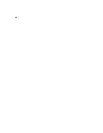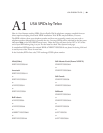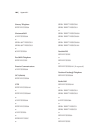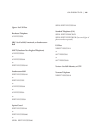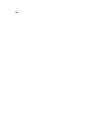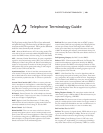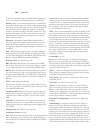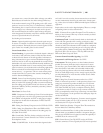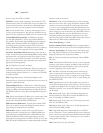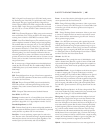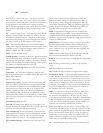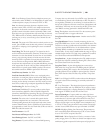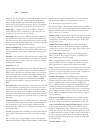106 | Appendix 2
number of trunks in the system.
DID Trunk- A Direct Inward Dialing Trunk. A trunk (channel)
which can only receive calls. A group of telephone numbers (DID
numbers) are associated with a given trunk group, however there
is no one-to-one correspondence between the individual channels
and these numbers. e PBX uses the DID number given it by the
phone company to route the channel to the correct DID extension
within the PBX. is allows some or all PBX stations to receive
calls directly without going through an attendant (or auto atten-
dant) Note that there are usually more DID numbers than there are
DID trunks. See DID number and DID extension.
Direct Inward Dialing- See DID
Directory Number (USA & Canada)- Your seven digit telephone
number (without the area code), as found in the telephone directory.
Directory 1&2 (Zephyr)- e Utility menu on the Zephyr where
the 7 digit Directory Numbers can be entered during set up. e
Zephyr generally does not require these numbers.
DN- See Directory Number. See also Directory 1 &2 and MSN/
DN 1 &2.
DNIS- Dialed Number Identification Service- A service, typically
offered by a long distance company on 800 lines, that provides the
number dialed by the caller. is allows a caller to receive specific
treatment depending on the number dialed.
DP - Dial Pulse. A method off sending address information by
either 1) Causing brief interruptions in loop current. or 2) Caus-
ing brief changes of state of a bit on a digital circuit using Channel
Associated Signaling. In other words, “rotary” or “pulse” dialing. See
also DTMF and CAS.
DSØ- Digital Signal Level Zero. e smallest unit of measure of
the standard rate hierarchy used by the Telcos (i.e. all other rates are
a multiple of the DSØ rate. For example, the T1 rate is 24 times the
DSØ rate and the E1 rate is 32 times the DSØ rate). 64 kbps. See
also B channel.
DS1-Digital Signal Level 1. e second level up the digital rate
hierarchy used by the Telcos. is is 24 times the DSØ rate for a
total of 1.544 mbps. See DSØ. See also T1.
DS2-Digital Signal Level 2. Data rate of 6.312 mbps (4 times the
DS1 rate). See DSØ and DS1.
DS3-Digital Signal Level 3. Data rate of 43.232 mbps (28 times
the DS1 rate). See DSØ and DS1.
DSL- Digital Subscriber Line. Traditionally refers to an ISDN
circuit or sometimes a T1 line, although the term is also frequently
used to mean the next generation beyond ISDN. Sometimes xDSL
is used to indicate that the writer is referring to any of a number of
emerging DSL technologies.
DSU- Data Service Unit. See CSU/DSU.
by the end user. See NCTE and DSX1
CSU/DSU- A device which incorporates the functions of a CSU
(Channel Service Unit) and a DSU (Data Service Unit) Most com-
monly it interfaces between a Switched-56 or Dedicated Digital
Service circuit and a user’s data equipment such as the Zephyr.
CSV- Circuit Switched Voice- A dial-up communications circuit
for voice grade communication. Also, the type of ISDN service re-
quired to use this capability of an ISDN circuit. In contrast to CSD
Custom ISDN (USA & Canada)- An ISDN protocol which
pre-dates National ISDN-1. In most cases National ISDN-1 is
also available. e Northern Telecom DMS-100 switch Supports
“DMS Custom Functional” ISDN. e AT&T/Lucent 5ESS
switch Supports “Custom Point-to-Point” (PTP) and Custom
Point-to-MultiPoint (PMP). e ISDN protocol has no relation to
where one may call. Telos equipment does not support PMP.
D Channel- Data/Delta Channel. Depending on who you ask, it
is Data or Delta. e channel which handles ISDN network-related
data between the user’s equipment and the Telco switch. Used to
carry data to set up calls and receive calls. Some Telco’s also allow
users to use the D channel to access the packet data network, with
appropriate terminal equipment.
D4- See Superframe. See also Line Format.
DCE- Data Communication Equipment. When using serial com-
munications such RS-232, V.35, or X.21, the DCE is the device
sending/receiving from the Telco line. i.e.: a modem or CSU/DSU.
In contrast to DTE.
DDS- Digital Data System- See Dedicated Digital Service.
Dedicated Circuit- A permanent channel between two locations. As
opposed to a Switched Circuit.
Dedicated Digital Service- a “Hardwired” or “Nailed Up” digital
circuit which is permanently connected between 2 points. Typically
56Kbps or 64Kbps. Dedicated digital lines are frequently cheaper
than ISDN for full time service. Also called Digital Data System or
DDS.
DID- Direct Inward Dialing. e ability for an outside caller to dial
to a PBX extension without going through an attendant or auto-
attendant. See also DID Number and DID Trunk.
DID Extension or DID station- A specific phone within a PBX
which can be called from the public telephone network without
going through an attendant or auto-attendant.
DID Number- A phone number used to route calls from the
telephone network to a specific phone in a PBX (the DID exten-
sion). DID requires special DID trunks or ISDN PRI “two-way
DID” trunks. Blocks of DID numbers (typically 10 or 20, some-
times higher) are purchased from the LEC or CLEC for use on the
PBX. e number of DID numbers usually substantially exceeds the



